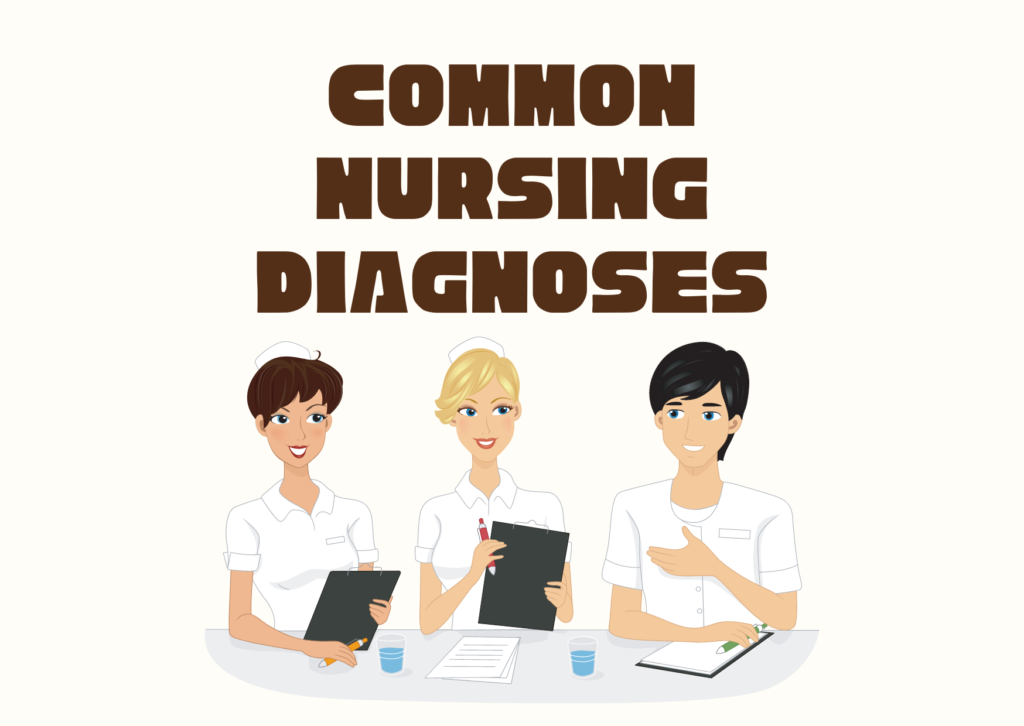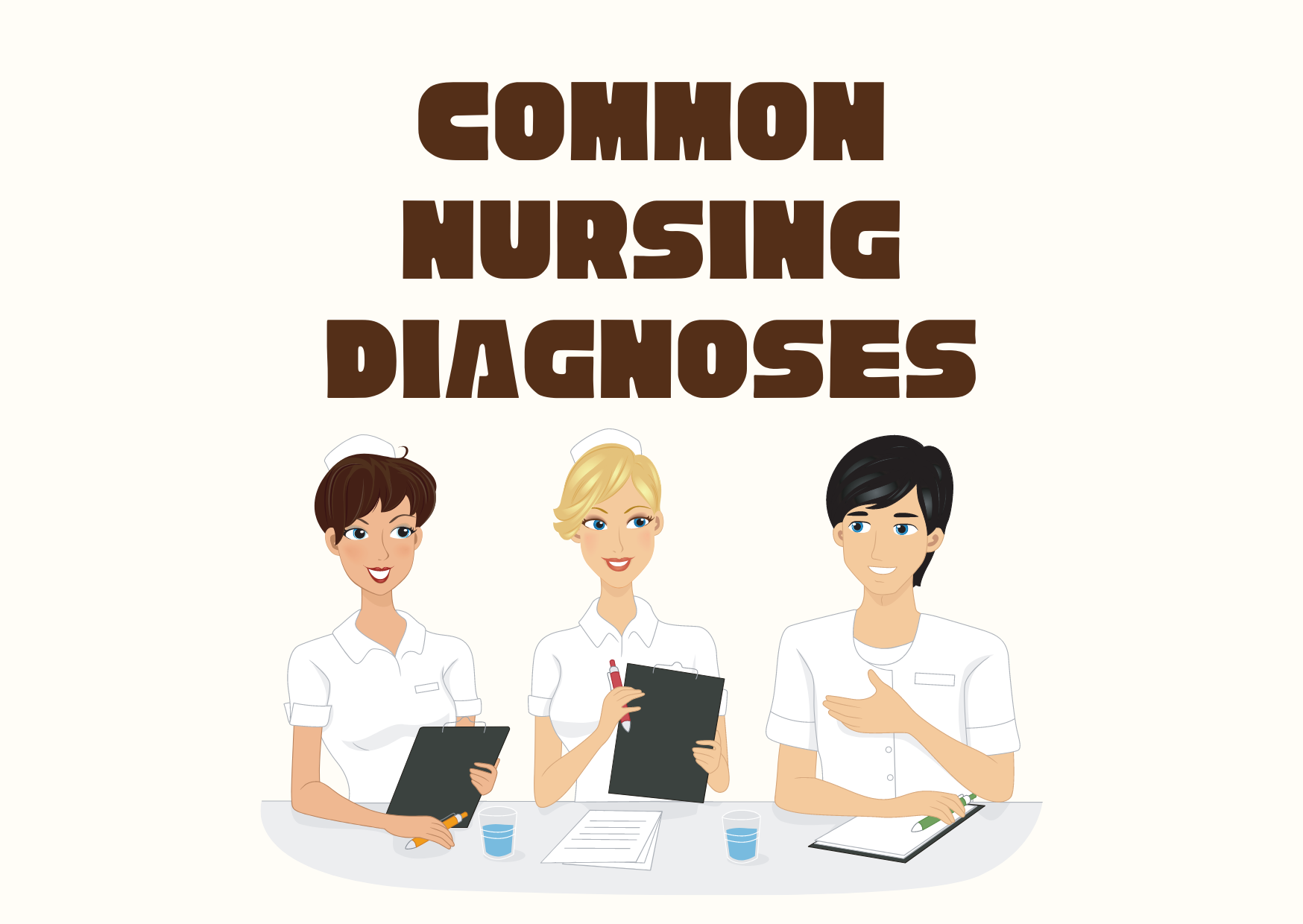The field of nursing is a complex and demanding one, requiring extensive knowledge, skills, and compassion to provide effective patient care. A key component of this care is the identification and management of nursing diagnoses, which are clinical judgments about a patient’s response to a health problem. Nursing diagnoses guide the development of individualized care plans and help nurses to provide targeted interventions that improve patient outcomes.
Thank you for reading this post, don't forget to subscribe!
There are many common nursing diagnoses that nurses encounter in their practice, ranging from anxiety and pain to impaired mobility and nutritional imbalances. Each of these diagnoses presents unique challenges for patients and caregivers alike, and requires careful assessment, planning, and intervention to address effectively.
In this blog post, we will explore 10 common nursing diagnoses and how to tackle them. We will provide an overview of each diagnosis, including its symptoms and causes, and discuss evidence-based nursing interventions for managing and treating these conditions. We will also offer practical tips for providing compassionate and effective care, as well as for preventing common complications associated with each diagnosis.
Our hope is that by reading this blog post, nurses and other healthcare professionals will gain a deeper understanding of these common nursing diagnoses and feel more equipped to provide high-quality, patient-centered care to those in need.

Anxiety
Anxiety is a common nursing diagnosis that can manifest in a variety of ways. It is characterized by feelings of fear, worry, and apprehension. Here are some key points to consider when managing anxious patients:
- Definition and symptoms of anxiety: Anxiety can cause physical symptoms such as heart palpitations, sweating, and trembling, as well as emotional symptoms such as fear and worry.
- Common causes of anxiety in patients: Anxiety can be caused by a wide range of factors, including illness, hospitalization, and medication side effects.
- Nursing interventions for managing anxiety: Nurses can use medication such as anti-anxiety drugs or non-medication options such as relaxation techniques and therapy to manage anxiety.
- Tips for providing emotional support to anxious patients: Nurses can provide emotional support to anxious patients by engaging in active listening, offering reassurance, and validating their feelings.
Impaired Physical Mobility
Impaired physical mobility is a nursing diagnosis that is commonly seen in patients with musculoskeletal or neurological disorders. It can cause pain, discomfort, and difficulty in performing daily activities. Here are some key points to consider when managing patients with mobility issues:
- Definition and symptoms of impaired physical mobility: Impaired physical mobility is characterized by difficulty in movement, pain, and discomfort.
- Common causes of impaired physical mobility in patients: Impaired physical mobility can be caused by musculoskeletal or neurological disorders, as well as injuries and surgical procedures.
- Nursing interventions for improving mobility: Nurses can use interventions such as range-of-motion exercises, assistive devices, and physical therapy to improve mobility.
- Tips for preventing complications associated with immobility: Nurses can prevent complications associated with immobility such as pressure ulcers and deep vein thrombosis by turning and repositioning patients regularly, providing skin care, and monitoring patients for signs of complications.
Ineffective Breathing Pattern
Ineffective breathing pattern is a nursing diagnosis that is commonly seen in patients with respiratory disorders. It can cause shortness of breath, fatigue, and a feeling of suffocation. Here are some key points to consider when managing patients with ineffective breathing pattern:
- Definition and symptoms of ineffective breathing pattern: Ineffective breathing pattern is characterized by shortness of breath, fatigue, and a feeling of suffocation.
- Common causes of ineffective breathing pattern in patients: Ineffective breathing pattern can be caused by a wide range of respiratory disorders, such as pneumonia or chronic obstructive pulmonary disease (COPD).
- Nursing interventions for improving breathing: Nurses can use interventions such as oxygen therapy, breathing exercises, and respiratory treatments to improve breathing.
- Tips for monitoring respiratory status and responding to respiratory distress: Nurses can monitor respiratory status by assessing vital signs, oxygen saturation levels, and lung sounds. They can respond to respiratory distress by administering oxygen, providing breathing treatments, and notifying the healthcare provider.
Disturbed Sleep Pattern
Disturbed sleep pattern is a nursing diagnosis that is commonly seen in hospitalized patients. It can cause fatigue, irritability, and difficulty concentrating. Here are some key points to consider when managing patients with disturbed sleep pattern:
- Definition and symptoms of disturbed sleep pattern: Disturbed sleep pattern is characterized by difficulty falling asleep, waking up frequently during the night, and feeling tired during the day.
- Common causes of disturbed sleep pattern in patients: Disturbed sleep pattern can be caused by a wide range of factors such as pain, medication administration, and hospital environment.
- Nursing interventions for improving sleep: Nurses can use interventions such as providing a quiet and dark environment, promoting relaxation techniques, and administering medication as prescribed to improve sleep.
- Tips for promoting healthy sleep habits: Nurses can educate patients on the importance of establishing a regular sleep routine, avoiding caffeine and alcohol, and incorporating exercise into their daily routine.
Risk for Infection
Risk for infection is a nursing diagnosis that is commonly seen in patients with compromised immune systems. It can be caused by a wide range of factors and can lead to serious complications if left untreated. Here are some key points to consider when managing patients at risk for infection:
- Definition and symptoms of risk for infection: Risk for infection is characterized by an increased susceptibility to infection and can cause symptoms such as fever, chills, and fatigue.
- Common causes of risk for infection in patients: Risk for infection can be caused by a variety of factors, such as immunosuppressive medications, surgical procedures, and chronic illness.
- Nursing interventions for preventing infection: Nurses can use interventions such as hand hygiene, proper use of personal protective equipment, and isolation precautions to prevent the spread of infection.
- Tips for educating patients on infection prevention: Nurses can educate patients on the importance of hand hygiene, avoiding contact with sick individuals, and reporting symptoms of infection promptly.
Acute Pain
Acute pain is a nursing diagnosis that is commonly seen in hospitalized patients. It can cause discomfort and distress, and if left untreated, can lead to further complications. Here are some key points to consider when managing patients with acute pain:
- Definition and symptoms of acute pain: Acute pain is characterized by a sudden onset and can cause symptoms such as discomfort, distress, and decreased mobility.
- Common causes of acute pain in patients: Acute pain can be caused by a variety of factors such as injury, surgery, and medical procedures.
- Nursing interventions for managing acute pain: Nurses can use interventions such as medication management, heat or cold therapy, and distraction techniques to manage acute pain.
- Tips for assessing and monitoring pain: Nurses can assess and monitor pain by using pain scales, asking open-ended questions, and evaluating patients for signs of distress.
Impaired Skin Integrity
Impaired skin integrity is a nursing diagnosis that is commonly seen in patients who are immobile or have limited mobility. It can cause pain, discomfort, and can lead to further complications such as infections. Here are some key points to consider when managing patients with impaired skin integrity:
- Definition and symptoms of impaired skin integrity: Impaired skin integrity is characterized by skin breakdown, such as pressure ulcers or wounds.
- Common causes of impaired skin integrity in patients: Impaired skin integrity can be caused by prolonged pressure, friction, and shearing forces on the skin.
- Nursing interventions for improving skin integrity: Nurses can use interventions such as turning and repositioning patients regularly, providing skin care, and using pressure-relieving devices to improve skin integrity.
- Tips for preventing complications associated with impaired skin integrity: Nurses can prevent complications associated with impaired skin integrity by monitoring patients for signs of skin breakdown, implementing preventive measures, and providing appropriate wound care.
Risk for Falls
Risk for falls is a nursing diagnosis that is commonly seen in elderly patients or those with impaired mobility. It can cause serious injuries and can lead to further complications. Here are some key points to consider when managing patients at risk for falls:
- Definition and symptoms of risk for falls: Risk for falls is characterized by an increased susceptibility to falls and can cause symptoms such as dizziness, balance issues, and decreased mobility.
- Common causes of risk for falls in patients: Risk for falls can be caused by a variety of factors such as medication side effects, environmental factors, and muscle weakness.
- Nursing interventions for preventing falls: Nurses can use interventions such as fall risk assessments, environmental modifications, and patient education to prevent falls.
- Tips for educating patients on fall prevention: Nurses can educate patients on the importance of wearing appropriate footwear, using assistive devices, and avoiding potential hazards in the environment.
Risk for Impaired Swallowing
Risk for impaired swallowing is a nursing diagnosis that is commonly seen in patients with neurological or neuromuscular disorders. It can cause serious complications such as aspiration pneumonia and malnutrition. Here are some key points to consider when managing patients at risk for impaired swallowing:
- Definition and symptoms of risk for impaired swallowing: Risk for impaired swallowing is characterized by an increased susceptibility to difficulties with swallowing and can cause symptoms such as coughing, choking, and food sticking in the throat.
- Common causes of risk for impaired swallowing in patients: Risk for impaired swallowing can be caused by a variety of factors such as stroke, Parkinson’s disease, and muscular dystrophy.
- Nursing interventions for improving swallowing function: Nurses can use interventions such as modifying the consistency of foods and fluids, providing swallowing exercises, and positioning patients properly during meals to improve swallowing function.
- Tips for preventing complications associated with impaired swallowing: Nurses can prevent complications associated with impaired swallowing by monitoring patients for signs of aspiration, providing appropriate nutrition and hydration, and educating patients on safe swallowing techniques.
Impaired Gas Exchange
Impaired gas exchange is a nursing diagnosis that can occur in patients with respiratory disorders such as pneumonia, chronic obstructive pulmonary disease (COPD), and acute respiratory distress syndrome (ARDS). It is characterized by inadequate oxygenation and/or ventilation and can lead to serious complications such as hypoxemia, hypercapnia, and respiratory failure. Here are some key points to consider when managing patients with impaired gas exchange:
- Definition and symptoms of impaired gas exchange: Impaired gas exchange is characterized by a disturbance in the diffusion of gases in the lungs and can cause symptoms such as dyspnea, cyanosis, and decreased oxygen saturation levels.
- Common causes of impaired gas exchange in patients: Impaired gas exchange can be caused by a variety of factors such as airway obstruction, alveolar damage, and decreased lung compliance.
- Nursing interventions for improving gas exchange: Nurses can use interventions such as positioning patients to optimize lung expansion, providing supplemental oxygen therapy, and encouraging coughing and deep breathing exercises to improve gas exchange.
- Tips for preventing complications associated with impaired gas exchange: Nurses can prevent complications associated with impaired gas exchange by monitoring patients for signs of hypoxemia and hypercapnia, providing appropriate respiratory support, and educating patients on proper breathing techniques.
Conclusion
Nursing diagnoses are essential for identifying patients’ health problems and developing appropriate nursing care plans. By understanding the common nursing diagnoses and how to tackle them, nurses can provide effective and efficient care for their patients. It is important for nurses to assess and monitor their patients closely and implement appropriate interventions to prevent complications and promote positive health outcomes. By working collaboratively with the healthcare team and utilizing evidence-based practice, nurses can provide high-quality care for their patients and improve overall patient outcomes.



